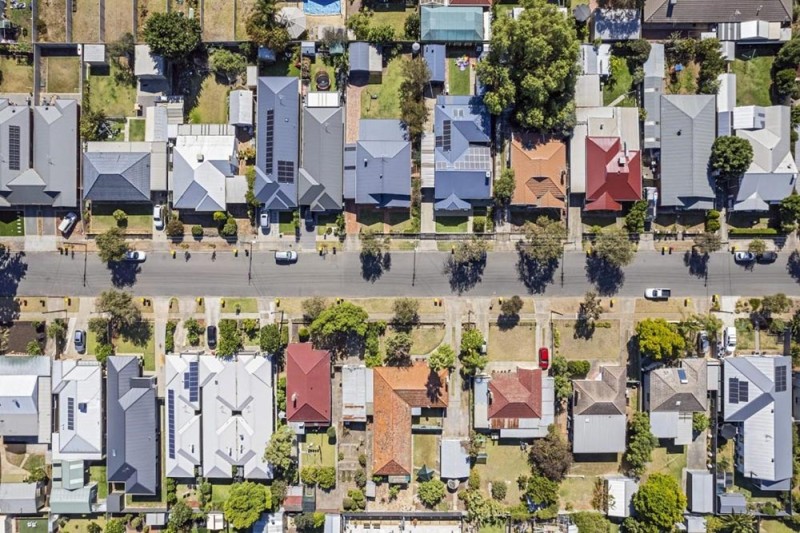
• 美国房贷利率始终居高不下,一直徘徊在7%左右,远高于疫情期间3%以下的水平。自2020年以来,美国房价已上涨逾50%,这使得拥有住房对许多美国人而言变得越来越遥不可及。
疫情期间,购房者习惯了3%以下的房贷利率,感觉买房的梦想更容易实现了。但在过去几年里,购房者就没那么幸运了。
2023年末,房贷利率曾一度飙升至8%。虽然之后略有回落,但根据《每日房贷新闻》的数据,目前30年期固定房贷利率仍高达6.75%。经济学家和房地产机构警告称,他们预计这一数字在短期内不会有大幅变动。更糟糕的是,一些人表示,要让人们再次感觉能买得起房所需达到的房贷利率水平是难以企及的。
上周二,Zillow的经济分析师阿努什娜·普拉卡什报告称,只有房贷利率下降到4.43%,普通购房人才能买得起一套普通住房。但普拉卡什写道:“目前看来,如此大幅度的利率下降是不现实的。”她补充道,在纽约、洛杉矶、迈阿密、旧金山、圣地亚哥或圣何塞这些城市,即使房贷利率降到0%,一套普通住房的购房成本依旧令人望而却步。
沃伦·巴菲特的伯克希尔-哈撒韦家居服务公司(Berkshire Hathaway HomeServices)也在7月初的一份报告中表示,房贷利率是阻碍购房者和售房者的主要因素之一。
该公司指出:“许多房主不愿将房屋挂牌出售,放弃他们已经享受的低房贷利率。对他们而言,房价大幅上涨带来的收益根本无法抵消他们在极高利率下另买一套房所需支付的更多费用。”
这一问题也被称为“金手铐”(golden handcuffs)——或称“房贷利率锁定效应”。其核心在于,当前房主即使想搬家,也没有动力将房屋挂牌出售,因为那样做将意味着放弃多年前锁定的低得多的房贷利率。
这给住房市场带来了一系列其他问题,尤其是库存问题。
根据伯克希尔-哈撒韦家居服务公司的数据,4月份待售现房数量环比增长了9%,达到145万套;按当前销售速度计算,这相当于4.4个月的供应量,为五年来的最高水平。越来越多卖家在房屋挂牌时间超出预期后选择撤牌,充分体现了这种趋势。
Realtor.com 的高级经济学家杰克·克里梅尔最近在《财富》杂志采访时表示:“房屋挂牌时间比去年延长了近三周。这表明卖家仍然固守着疫情期间的房价预期,尽管市场传递的信号恰恰相反。”
这并不意味着美国住房供应激增;事实上,我们仍然短缺数百万套住房。这只是意味着,真正能买得起房的人不够多。
影响住房负担能力的因素
尽管库存水平上升,但房价和房贷利率仍然是潜在购房者的障碍。伯克希尔-哈撒韦家居服务公司表示,房贷利率一直“居高不下”,阻碍了新买家进入市场。
根据Realtor.com周四发布的一份报告,7月份一套普通住房的平均挂牌时间为58天,比去年同期长了7天。
房贷利率无疑是购房者决定是否出价的一个重要考量因素,而且根据美国凯斯-席勒房价指数数据,自疫情爆发以来,房价也已上涨逾50%。
与此同时,工资的增长速度未能跟上房屋增值的步伐,让人们觉得买房更加难以负担。科克伦集团(The Corcoran Group)的房地产经纪人亚历山德拉·古普塔对《财富》杂志表示,如果房贷利率、房屋库存或工资增长等方面没有改观,美国的住房可负担性危机很可能将持续下去。
古普塔表示:“一些首次购房者转而选择长期租房甚至合租模式,因为购房已经变得遥不可及。另一些人则更多地依赖家庭支持才能进入市场。我们看到住房阶梯正在重塑。”
不过,根据凯斯-席勒指数,房价增长似乎正在放缓,这带来了一丝希望。
标普道琼斯指数固定收益可交易品和大宗商品主管尼古拉斯·戈德克在一份声明中表示:“由于房屋可负担性压力依然存在,且库存紧张,全国房价基本持稳,但也仅仅是勉强维持。”(*)
译者:刘进龙
审校:汪皓
• 美国房贷利率始终居高不下,一直徘徊在7%左右,远高于疫情期间3%以下的水平。自2020年以来,美国房价已上涨逾50%,这使得拥有住房对许多美国人而言变得越来越遥不可及。
疫情期间,购房者习惯了3%以下的房贷利率,感觉买房的梦想更容易实现了。但在过去几年里,购房者就没那么幸运了。
2023年末,房贷利率曾一度飙升至8%。虽然之后略有回落,但根据《每日房贷新闻》的数据,目前30年期固定房贷利率仍高达6.75%。经济学家和房地产机构警告称,他们预计这一数字在短期内不会有大幅变动。更糟糕的是,一些人表示,要让人们再次感觉能买得起房所需达到的房贷利率水平是难以企及的。
上周二,Zillow的经济分析师阿努什娜·普拉卡什报告称,只有房贷利率下降到4.43%,普通购房人才能买得起一套普通住房。但普拉卡什写道:“目前看来,如此大幅度的利率下降是不现实的。”她补充道,在纽约、洛杉矶、迈阿密、旧金山、圣地亚哥或圣何塞这些城市,即使房贷利率降到0%,一套普通住房的购房成本依旧令人望而却步。
沃伦·巴菲特的伯克希尔-哈撒韦家居服务公司(Berkshire Hathaway HomeServices)也在7月初的一份报告中表示,房贷利率是阻碍购房者和售房者的主要因素之一。
该公司指出:“许多房主不愿将房屋挂牌出售,放弃他们已经享受的低房贷利率。对他们而言,房价大幅上涨带来的收益根本无法抵消他们在极高利率下另买一套房所需支付的更多费用。”
这一问题也被称为“金手铐”(golden handcuffs)——或称“房贷利率锁定效应”。其核心在于,当前房主即使想搬家,也没有动力将房屋挂牌出售,因为那样做将意味着放弃多年前锁定的低得多的房贷利率。
这给住房市场带来了一系列其他问题,尤其是库存问题。
根据伯克希尔-哈撒韦家居服务公司的数据,4月份待售现房数量环比增长了9%,达到145万套;按当前销售速度计算,这相当于4.4个月的供应量,为五年来的最高水平。越来越多卖家在房屋挂牌时间超出预期后选择撤牌,充分体现了这种趋势。
Realtor.com 的高级经济学家杰克·克里梅尔最近在《财富》杂志采访时表示:“房屋挂牌时间比去年延长了近三周。这表明卖家仍然固守着疫情期间的房价预期,尽管市场传递的信号恰恰相反。”
这并不意味着美国住房供应激增;事实上,我们仍然短缺数百万套住房。这只是意味着,真正能买得起房的人不够多。
影响住房负担能力的因素
尽管库存水平上升,但房价和房贷利率仍然是潜在购房者的障碍。伯克希尔-哈撒韦家居服务公司表示,房贷利率一直“居高不下”,阻碍了新买家进入市场。
根据Realtor.com周四发布的一份报告,7月份一套普通住房的平均挂牌时间为58天,比去年同期长了7天。
房贷利率无疑是购房者决定是否出价的一个重要考量因素,而且根据美国凯斯-席勒房价指数数据,自疫情爆发以来,房价也已上涨逾50%。
与此同时,工资的增长速度未能跟上房屋增值的步伐,让人们觉得买房更加难以负担。科克伦集团(The Corcoran Group)的房地产经纪人亚历山德拉·古普塔对《财富》杂志表示,如果房贷利率、房屋库存或工资增长等方面没有改观,美国的住房可负担性危机很可能将持续下去。
古普塔表示:“一些首次购房者转而选择长期租房甚至合租模式,因为购房已经变得遥不可及。另一些人则更多地依赖家庭支持才能进入市场。我们看到住房阶梯正在重塑。”
不过,根据凯斯-席勒指数,房价增长似乎正在放缓,这带来了一丝希望。
标普道琼斯指数固定收益可交易品和大宗商品主管尼古拉斯·戈德克在一份声明中表示:“由于房屋可负担性压力依然存在,且库存紧张,全国房价基本持稳,但也仅仅是勉强维持。”(*)
译者:刘进龙
审校:汪皓
• Mortgage rates have remained stubbornly high: hovering near 7%, well above the sub-3% rates during the pandemic. That makes homeownership increasingly unaffordable for many Americans, as home prices have risen over 50% since 2020.
During the pandemic, home buyers got accustomed to sub-3% mortgage rates, which made purchasing a house feel more achievable. But in the past couple of years, buyers have had no such luck.
In late 2023, mortgage rates peaked at 8%. While they’ve let up some, today’s 30-year fixed mortgage rate is 6.75%, according to Mortgage News Daily. Economists and real-estate groups have warned they don’t see that figure budging much in the near future. And to make matters worse, some have said the mortgage rate it would take to make homes feel affordable again isn’t achievable.
On Tuesday, Zillow economic analyst Anushna Prakash reported mortgage rates would need to drop to 4.43% for a typical home to be affordable to an average buyer. But “that kind of a rate decline is currently unrealistic,” Prakash wrote. Meanwhile, not even a 0% interest rate would make a typical home affordable in New York, Los Angeles, Miami, San Francisco, San Diego, or San Jose, she added.
Warren Buffett’s Berkshire Hathaway HomeServices also said in an early July report that mortgage rates are one of the main deterrents for both home buyers and sellers.
“Many homeowners are reluctant [to] put their homes on the market and give up the low mortgage rates they already have,” according to Berkshire Hathaway HomeServices. “To them, high price gains won’t mitigate their ability to pay more for another home at significantly higher interest rates.”
This issue is also referred to as golden handcuffs—or the locked-in mortgage rate effect. The idea is that current homeowners have no incentive to put their homes on the market, even if they want to move, because they’d forgo a much lower mortgage rate they had locked in years ago.
This causes a litany of other problems in the housing market, namely inventory.
The number of unsold existing homes for sale rose 9% month-over-month in April, according to Berkshire Hathaway HomeServices, to 1.45 million; that’s equal to 4.4 months’ supply on hand at the current sales pace and the highest level in five years. That’s shown itself in more sellers delisting their properties after sitting on the market for longer than expected.
“Homes are sitting on the market nearly three weeks longer than last year,” Realtor.com Senior Economist Jake Krimmel recently told Fortune. “That’s a sign of sellers still anchored to pandemic-era prices even though the market is telling them otherwise.”
That doesn’t mean there’s an influx of housing in the U.S.; in fact, we’re still short millions of units. It just means there aren’t enough people who can actually afford to buy a home.
The factors influencing housing affordability
Although inventory levels are increasing, home prices and mortgage rates continue to be a roadblock for potential home buyers. Mortgage rates have remained “stubbornly high,” Berkshire Hathaway HomeServices said, deterring new buyers from the market.
According to a Realtor.com report published Thursday, the typical home spent 58 days on the market in July, which is 7 days longer than the same time last year.
Mortgage rates are certainly a factor among buyers when deciding to make an offer, and home prices are also up more than 50% since the onset of the pandemic, according to the U.S. Case-Shiller Home Price Index.
All the while, wages haven’t grown at the same pace as home appreciation, making buying a house feel even more unaffordable. And if nothing changes like mortgage rates, inventory, or wage growth, it’s likely the housing affordability crisis in the U.S. will persist, Alexandra Gupta, a real-estate broker with The Corcoran Group, told Fortune.
“Some first-time buyers are turning to long-term renting or even co-living models because the idea of owning a home has become so out of reach. Others are relying more on family support to get into the market,” Gupta said. “We’re seeing a reshaping of the housing ladder.”
The small glimmer of hope, though, is home price growth appears to be slowing, according to the Case-Shiller indices.
“With affordability still stretched and inventory constrained, national home prices are holding steady, but barely,” Nicholas Godec, head of fixed-income tradables and commodities at S&P Dow Jones Indices, said in a statement.

